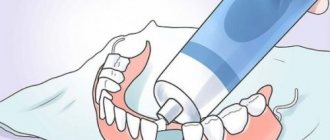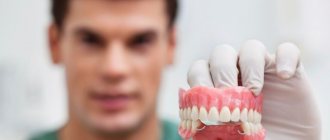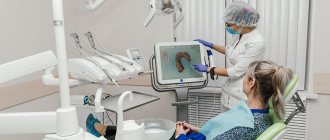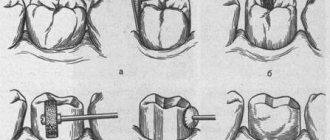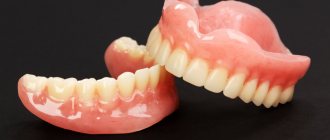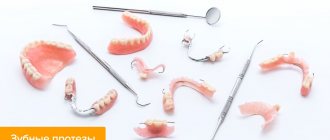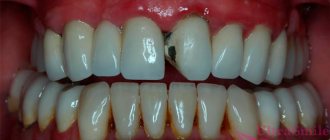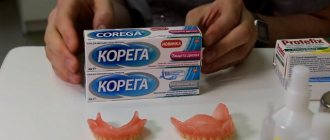It is not always that a removable denture made in a clinic becomes your daily assistant. Often it collects dust in a glass at home, and for various reasons: the denture simply does not stay in the mouth, or it does, but you feel complete discomfort when chewing. The reason for this could be a variety of factors. For example, you decided to save money and turned to a small and very affordable office that does not specialize in prosthetics and certainly does not have its own dental laboratory. The doctor incorrectly determined the bite of the “toothless” patient, and the third-party dental technician, whom the doctor had to contact to make a prosthesis for you, did not fully understand the doctor and, accordingly, did not take into account all his requirements when making this design. It may be that both the doctor and the technician worked perfectly, and the result was a high-quality removable denture. But as soon as you got teeth, even removable ones, you immediately forgot about your yesterday’s troubles and did not bother about annual dental check-ups. As a result, the prosthesis is damaged - and everything is done again...
How to restore front teeth
It is important to understand what specific problem we are talking about here.
- If a tooth falls out or is removed, implantation is the best option to restore it.
- If only the coronal part is broken, you can consider the option of replacing the front tooth with a crown (with preliminary installation of a reinforcing tab in the root canal).
- If we are talking about chips, cracks, severe destruction of part of the crown, aesthetic dentistry instruments are used. Aesthetic dental reconstruction aims to improve their natural appearance and allows the tooth to be restored even if it is severely damaged. The only requirement is to preserve part of the crown.
PROMOTION
Zirconium crowns and bridges
RUB 12,500
Implantation of lower teeth is the best solution
Dental implants are artificial tooth roots, most often made of titanium (can also be ceramic or tantalum), a biocompatible metal, or its alloys. The word is made up of the Latin "im" meaning "inside" and "planta" meaning "sapling". Thus, implantology deals with replacing lost tooth roots with artificial ones through the installation of dental implants.
Implants for the lower jaw in the absence of teeth are inserted into the bone tissue, and then the dentist fixes a crown, fixed bridge or removable denture on them. Dental implants not only maintain the strength of your chewing muscles, but also strengthen your jaw bones. They help maintain facial proportions. Dental restoration with implants helps prevent the signs of aging. After implantation, patients look younger.
According to foreign statistics accumulated since the 1960s, the service life of a correctly installed implant ranges from 20 years to life. The service life depends significantly on the patient’s discipline in oral hygiene.
Dental restoration methods
The clinics of the Amazing Prices Dentistry network in Moscow use materials for prosthetics of front teeth that ideally reflect the shape and color of natural enamel. Even the most difficult cases of chipped, abnormally pigmented or broken teeth can be easily corrected with one of the following methods to restore a beautiful smile.
- Veneers
The most beautiful restorations of the front teeth are performed with veneers. These are microprostheses in the form of thin ceramic overlays that are attached to the outside of the teeth. Thanks to the diffusion of natural light into the ceramic layer, the teeth look exceptionally natural. Veneers can be used if the enamel is sufficient in quantity and quality. This method is designed to hide a wide variety of dental damage. It is important to understand that veneers are installed in a complex - eight (minimum six) overlays for each row of teeth. Therefore, if the problem is with just one tooth, this option is not always advisable to use. Any malocclusions, tooth decay, or gingivitis must be treated before veneers are placed. It is also recommended to whiten your teeth before prosthetics using veneers.
- Single crown
Restoring a tooth after root canal treatment or a fracture of the coronal part can be performed using a single prosthesis - a crown. It covers the tooth, restores its natural appearance, strengthens it and provides the same comfort as natural teeth. The material you can choose is solid ceramics - the best option for prosthetics of front teeth, premium zirconium dioxide or standard metal ceramics. Crowns made of solid ceramics are very aesthetic and therefore are often used in dentistry to restore the frontal area.
- Bridge prosthetics
Another popular direction in dental practice, which is used if the front tooth has fallen out or been removed for medical reasons. With the help of a bridge, you can restore not only one missing unit, but also two or three missing teeth in a row. Materials for bridges are solid ceramics, metal ceramics, zirconium dioxide. The doctors at Amazing Price Dentistry will help you choose an option that will suit you in appearance, durability and cost.
The main factors that influence the choice of prosthesis
Orthopedic dentistry today offers a wide variety of designs for restoring any number of teeth. To choose the best one, it is necessary to take into account both objective and subjective factors:
- Medical indications and contraindications. The condition of neighboring units, soft and hard tissues, general health indicators, the presence of allergies, and age are important.
- Patient's wishes regarding the aesthetics of prosthetic structures. If you need to restore your front teeth, it is advisable to choose crowns made of metal-free ceramics or zirconium dioxide.
- Requirements for ease of use and functionality. Dentures made from modern high-tech materials are well retained in the oral cavity and make it possible to chew any food normally.
- Financial restrictions. Often, the cost of a prosthesis becomes one of the main factors that influences the patient’s final choice.
In what cases does restoration not make sense?
Many of our patients ask this question. We always answer objectively when it is really worth investing not in restoring your own tooth, but in installing an implant. Of course, there is no clear solution, because each clinical case is individual, but there are many situations where we know for sure that installing an implant will be a much better solution for the patient, both for clinical and financial reasons.
- If the front tooth has already undergone endodontic treatment several times (especially if the treatment was carried out under a microscope), and there are still inflammatory changes in the area of the root apexes, there is no point in treating the root canal again, but it is better to remove the tooth and insert an implant.
- A similar situation occurs when we have a severely damaged coronal part of the tooth due to a subgingival fracture of the tooth, or when a carious cavity reaches the root of the tooth and prosthetic reconstruction using a coronal inlay and a prosthetic crown is very doubtful. In such a situation, it is also better to consider the option of implantation.
The main methods of treating missing lower teeth
In the case where a tooth is completely missing (even the root is missing), restoration of the lower jaw teeth is carried out using one of the methods below:
- Installation of a fixed bridge prosthesis. The method is used when one or more teeth are destroyed or lost; the remaining healthy teeth serve as supports for the bridge structure. Fixed dentures cannot redistribute the chewing load on the jaw; therefore, when chewing, the load is not distributed evenly, but only on the supporting teeth to which the denture is attached. The fixation of fixed dentures is permanent, and it is impossible to remove such dentures yourself without the help of a dentist. The advantages of the method are aesthetic characteristics, restoration of chewing function, fast treatment time and relative low cost compared to dental implantation. Disadvantages - the need to depulp possibly healthy teeth, uneven distribution of the load, ongoing atrophy of the bone tissue of the alveolar crest in places where teeth are missing.
- Use of removable dentures. Most often they are used for long-term defects in the dentition (the absence of 3 or more teeth in a row). However, sometimes they are used in the absence of only 1-2 teeth (butterfly dentures) - if the patient does not want to undergo implantation or grind adjacent teeth for crowns. It is recommended to remove removable dentures once a day for hygienic procedures. Such dentures are less comfortable than fixed ones, because... occupy a significantly larger volume. Due to anatomical features, removable dentures for the lower teeth are smaller in size than the upper ones. Advantages: low cost, minimally invasive treatment, acceptable aesthetics. Disadvantages - does not restore chewing function, does not prevent bone tissue atrophy, the need for daily removal and periodic relining.
- Dental implantation. Implants are installed both when one or several teeth are lost in a row. Their purpose is to replace the biological root of a tooth; in prosthetics, implants are used as supports for artificial crowns: metal-ceramic or ceramic with a zirconium dioxide frame. Three main stages of implantation: installation of the implant into the bone tissue, formation of aesthetic gums, fixation of abutments on the implants and installation of crowns on the abutments. Implants can also be used in cases of complete absence of teeth in the lower jaw. The main advantage of implantation is the almost complete restoration of chewing function, and, as a result, the cessation of bone atrophy; such prosthetics also provide excellent aesthetics.
If the root of the tooth is not removed and there is a possibility of preserving it for use under a fixed prosthesis, the stump of the tooth is first restored, onto which a crown - metal-ceramic or completely ceramic - is fixed.
Sign up for front teeth restoration
Chips and caries should not be taken lightly, not only for aesthetic reasons, but also for health reasons. Repairing a cracked or chipped tooth does not cost much, but if neglected, the cost of restoring the tooth can add up significantly. Thus, at Amazing Price Dentistry, the cost of veneering is 12,500 rubles per tooth, a metal-ceramic crown made in Germany is 3,450 rubles. Zirconium and all-ceramic dentures – from 10,000 rubles per tooth. Implantation of one tooth with prosthetics – from 18,000 rubles.
Veneers for front teeth
Veneers: pros and cons
Prosthetics of molars at the ILATAN clinic
Modern dentistry offers many durable solutions that provide maximum patient comfort while at the same time providing excellent aesthetic, functional and therapeutic results. When choosing a prosthetic restoration, we take into account the patient's existing conditions and expectations. By scheduling a free consultation with an orthopedist or implantologist at any of the ILATAN family dentistries by phone, you will find out which dental restoration option is right for you and can take advantage of high-quality dental services at affordable prices.
Features of implantation of lower chewing teeth
The chewing teeth of the lower jaw bear the highest load. Implantation of the lower teeth should be carried out after preliminary planning and modeling of future teeth, since in some cases, the artificial root will have to withstand the load, which was previously distributed over 3-4 natural tooth roots. And the chewing force is calculated to be at least 30 - 40 kg per tooth.
Another argument in favor of planning is that the diameter of the implant neck is smaller than the conventional neck diameter of the biological posterior tooth, which means that the shoulder between the crown and the implant will be larger, and any deviation of the implant axis from the direction of the application axis will lead to greater negative consequences.
Therefore, classical implantation with preliminary planning, in two stages with delayed loading, is an ideal option for restoring lower chewing teeth. That is, first an implant is installed, and then, a few months later, a permanent crown is fixed onto it.
Sometimes, before dental implantation, bone grafting is required - a surgical operation to build up bone tissue at the site where the implant is supposed to be installed. The fact is that for implantation to be effective, certain parameters of bone tissue are required - height, width and density, and if tooth extraction was traumatic or a lot of time passed between tooth loss and implantation, then most likely the bone has atrophied.
Manufacturing of a partial cosmetic removable denture for 1 tooth
If you do not want to grind adjacent healthy teeth, and it is impossible to install implants, it is possible to replace 1 tooth using a small removable denture. Such a prosthesis is also called a “cosmetic bag” due to the fact that it restores only aesthetics. Such a removable denture does not restore chewing function and must be removed for cleaning. Typically, such a structure is made temporarily - for the period of bone tissue restoration, for example, after tooth extraction in the smile line and when immediate implantation is not possible.

